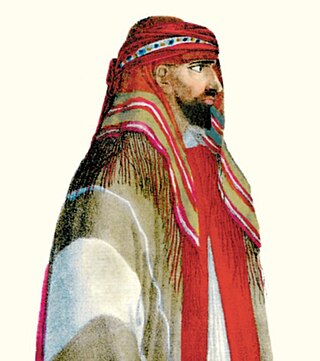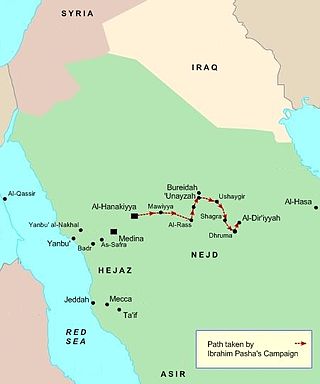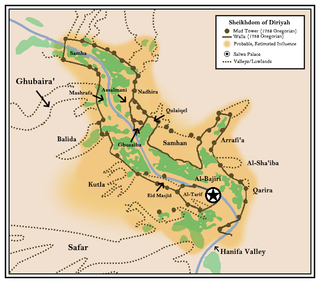
The Hejaz is a region that includes the majority of the west coast of Saudi Arabia, covering the cities of Mecca, Medina, Jeddah, Tabuk, Yanbu, Taif and Baljurashi. It is thus known as the "Western Province", and it is bordered in the west by the Red Sea, in the north by Jordan, in the east by the Najd, and in the south by the Region of 'Asir. Its largest city is Jeddah, which is the second-largest city in Saudi Arabia, with Mecca and Medina, respectively, being the fourth- and fifth-largest cities in the country.

Taif is a city and governorate in the Province of Makkah in Saudi Arabia. Located at an elevation of 1,879 m (6,165 ft) in the slopes of the Hijaz Mountains, which themselves are part of the Sarat Mountains, the city has a population of 563,282 people in 2022, making it one of the most populous cities in the kingdom.

Abdullah bin Saud Al Saud was the last ruler of the First Saudi State, from 1814 to 1818, and was executed in Constantinople under the Ottoman Empire. Although the Ottomans maintained several garrisons in the Nejd thereafter, they were unable to prevent the rise of the Emirate of Nejd, also known as the Second Saudi State, led by Turki bin Abdullah.
The Wahhabi war, also known as the Ottoman–Saudi war, was fought from early 1811 until 1818 between the Ottoman Empire, its vassal the Eyalet of Egypt, and the Emirate of Diriyah, the First Saudi State, resulting in the destruction of the latter.

The Emirate of Diriyah, also known as the first Saudi state, was established in February 1727. In 1744, the emir of a Najdi town called Diriyah, Muhammad bin Saud, and the religious leader Muhammad ibn Abd al-Wahhab signed a pact to found a socio-religious reform movement to unify the many states of the Arabian Peninsula.
Al-Ghamdi is an Arabic family name denoting a member of the Ghamd tribe of Saudi Arabia.
The capture of Yanbu, or Yanbu Landing, was a bloodless confrontation between the Saudis and Ottomans in 1811.
The Battle of Al-Safra took place in late 1811, when Tusun Pasha's forces engaged with Saudi forces led by Saud bin Abdulaziz. It was a resounding Saudi victory against the Ottoman forces.

The Battle of Medina took place in 1812, Following the Battle of Al-Safra, Tusun's forces began to deal with Saudi forces stationed in Medina.

The capture of Mecca in 1813 happened several days after the capture of Jeddah during the Ottoman–Saudi War.

The Najd Expedition was a series of military conflicts waged by Egypt on behalf of the Ottoman Empire from 1817 to 1818. It was part of the Ottoman–Saudi War that lasted from 1811 to 1818. The campaign of 1817/8 was led by Ibrahim Pasha, with the goal of capturing Diriyah and ending the First Saudi State by the order of the Ottoman sultan Mahmud II, through no real strategy other than brute force.

The siege of Diriyah took place in late 1818 at the end of the Wahhabi War of 1811–1818 during the Nejd Expedition.
Sultan bin Bajad bin Humaid al-'Utaybi was the Sheikh of the Otaibah tribe and one of the prominent leaders of the Ikhwan movement in the Arabian Peninsula. This tribal army supported King Abdulaziz in his efforts to unify Saudi Arabia between 1910 and 1927.

The Sharifate of Mecca or Emirate of Mecca was a state, non-sovereign for much of its existence, ruled by the Sharif of Mecca. A sharif is a descendant of Hasan ibn Ali, Muhammad's grandson. In Western sources, the prince of Mecca was known as Grand Sherif, but Arabs have always used the appellation "Emir".
The Ghamd is an Azd Arab tribe of the Hejaz Region. They are predominantly Sunni, and are considered one of the oldest tribes of the Arabian Peninsula. The Ghamid people are thought to be closely related to the neighboring tribe of Zahran.
The Capture of Al Hinakiyah was a military engagement between the Saudi army led by Saud bin Abdulaziz and the Ottoman garrison, who were stationed at Al Hinakiyah, they successfully expelled the Ottoman garrison.
The Battle of Turuba took place in 1813 when Ottoman forces besieged Turubah. The garrison was led by Ghaliyya Al Bogammiah who successfully routed the Ottoman army.
In 1814, the Emirate of Diriyah, as part of the Ottoman-Saudi War, launched a counter-attack to retake back the city of Al Qunfudhah from the Ottoman Empire who had held the city for a month. The attack was successful and the city was retaken.
The Al Bahah Expedition was a military expedition launched by the Ottoman army against the Zahran tribes in Al Bahah. The operation ended in another Ottoman defeat.
The Battle of Byssel was a military engagement between the Ottoman forces and the Saudi forces in Byssel. The Ottomans won a decisive battle, which broke Saudi power.








